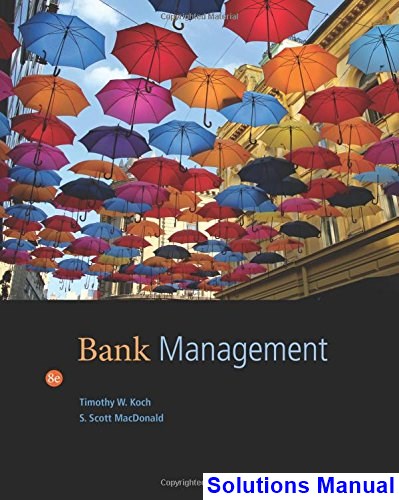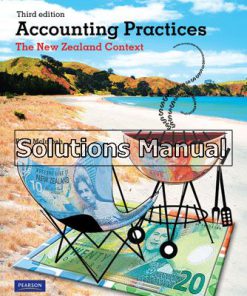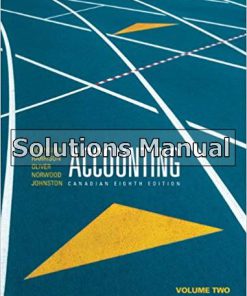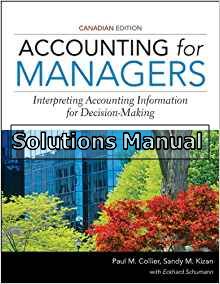Bank Management 8th Edition Koch Solutions Manual
You may also like
-
$26.50
$50.00 -
$26.50
$50.00 -
$26.50
$50.00 -
$26.50
$50.00
This is completed downloadable of Bank Management 8th Edition Koch Solutions Manual

Product Details:
- ISBN-10 : 1133494684
- ISBN-13 : 978-1133494683
- Author:
Closely examine the impact of today’s changing, competitive environment on commercial banks and banking services, as well as the entire financial services industry, with Koch/MacDonald’s BANK MANAGEMENT, 8E. This new edition reflects the latest changes and developments, from complete regulatory updates to details of the many programs evolving amidst today’s financial crises. The book’s unique approach to understanding bank management focuses on decision-making in today’s financial world. Whether you are a practicing or future professional, the book clearly demonstrates how certain factors influence credit, investment, funding, and pricing decisions. The book’s solid framework provides an appreciation and understanding of the trade-offs between return and risk. You gain a better understanding of the most important issues confronting financial and banking managers today as the book discusses basic financial models used to formulate decisions and analyzes the strengths and weaknesses of data analysis. With the help of this latest edition, you develop the logical thought processes needed to achieve strong financial and management results.
Table of Content:
- Ch 1: Banking and the Financial Services Industry
- Global Financial Crisis of 2007-2009
- How Do Banks Differ?
- Organizational Structure
- Financial Services Business Models
- Too Big to Fail Banks
- Different Channels for Delivering Banking Services
- Summary
- Questions
- Activities
- References
- Ch 2: Government Policies and Regulation
- Historical Bank Regulation
- Goals and Functions of Depository Institution Regulation
- Ensure Safety and Soundness and Provide an Efficient and Competitive System
- New Charters
- Shortcomings of Restrictive Bank Regulation
- Maintaining Monetary Stability and the Integrity of the Payments System
- Efficient and Competitive Financial System
- Too Big to Fail
- Summary
- Questions
- Activities
- References
- Ch 3: Analyzing Bank Performance
- Commercial Bank Financial Statements
- The Relationship between the Balance Sheet and Income Statement
- The Return on Equity Model
- Managing Risk and Returns
- Financial Statement Manipulation
- Summary
- Questions
- Problems
- References
- Appendix
- Ch 4: Managing Noninterest Income and Noninterest Expense
- Noninterest Income
- Noninterest Expense
- Which Lines of Business and Customers are Profitable?
- Summary
- Questions
- Activity
- References
- Ch 5: The Performance of Nontraditional Banking Companies
- The Disappearance of Large Investment Banks
- Goldman Sachs Group, Inc. and Goldman Sachs Bank USA
- The Financial Performance of Mutual of Omaha Bank
- The Financial Performance of BMW Financial Services and BMW Bank of North America
- Summary
- Questions
- Activities
- References
- Ch 6: Pricing Fixed-Income Securities
- The Mathematics of Interest Rates
- Simple versus Compound Interest
- The Relationship between Interest Rates and Option-Free Bond Prices
- Duration and Price Volatility
- Recent Innovations in the Valuation of Fixed-Income Securities and Total Return Analysis
- Money Market Yields
- Summary
- Questions
- Activities
- References
- Ch 7: Managing Interest Rate Risk: GAP and Earnings Sensitivity
- Measuring Interest Rate Risk with GAP
- Earnings Sensitivity Analysis
- Income Statement GAP
- Managing the GAP and Earnings Sensitivity Risk
- Summary
- Questions
- Activities
- References
- Ch 8: Managing Interest Rate Risk: Economic Value of Equity
- Measuring Interest Rate Risk with Duration Gap
- Economic Value of Equity Sensitivity Analysis
- Earnings Sensitivity Analysis versus EVE Sensitivity Analysis: Which Model is Better?
- A Critique of Strategies for Managing Earnings and Economic Value of Equity Sensitivity
- Yield Curve Strategies
- Summary
- Questions
- Activity
- References
- Ch 9: Using Derivatives to Manage Interest Rate Risk
- Characteristics of Financial Futures
- Speculation versus Hedging
- Microhedging Applications
- Macrohedging Applications
- Using Forward Rate Agreements to Manage Rate Risk
- Basic Interest Rate Swaps as a Risk Management Tool
- Interest Rate Caps and Floors
- Summary
- Questions
- Activities
- References
- Ch 10: Funding the Bank
- The Relationship between Liquidity Requirements, Cash, and Funding Sources
- Characteristics of Retail-Type Deposits
- Characteristics of Large Wholesale Liabilities
- Electronic Money
- Check 21
- Measuring the Cost of Funds
- The Average Historical Cost of Funds
- Funding Sources and Banking Risks
- Summary
- Questions
- Problems
- References
- Ch 11: Managing Liquidity
- Meeting Liquidity Needs
- Reserve Balances at the Federal Reserve Bank
- Required Reserves and Monetary Policy
- Meeting Legal Reserve Requirements
- Liquidity Planning
- Traditional Aggregate Measures of Liquidity Risk
- Basel III and the Liquidity Coverage Ratio
- Longer-Term Liquidity Planning
- Contingency Funding Plans
- Summary
- Questions
- Activity
- References
- Ch 12: The Effective Use of Capital
- Why Worry about Bank Capital?
- Risk-Based Capital Standards
- What Constitutes Bank Capital?
- Tangible Common Equity
- What is the Function of Bank Capital?
- How Much Capital is Adequate?
- The Effect of Capital Requirements on Bank Operating Policies
- Characteristics of External Capital Sources
- Contingent Convertible Capital
- Capital Planning
- Depository Institution Capital Standards
- Changes to Capital Standards under Basel III
- Summary
- Questions
- Problems
- References
- Ch 13: Overview of Credit Policy and Loan Characteristics
- Recent Trends in Loan Growth and Quality
- Measuring Aggregate Asset Quality
- The Credit Process
- Characteristics of Different Types of Loans
- Summary
- Questions
- Problems
- Activity
- References
- Ch 14: Evaluating Commercial Loan Requests and Managing Credit Risk
- Fundamental Credit Issues
- Evaluating Credit Requests: A Four-Part Process
- Credit Analysis Application: Wade’s Office Furniture
- Managing Risk with Loan Sales and Credit Derivatives
- Summary
- Questions
- Problems
- References
- Appendix I: Calculation of Financial Ratios
- Appendix II: Background Information for Financial Analysis
- Appendix III
- Ch 15: Evaluating Consumer Loans
- Types of Consumer Loans
- Consumer Credit Regulations
- Credit Analysis
- Recent Risk and Return Characteristics of Consumer Loans
- Summary
- Questions
- Problems
- Activities
- References
- Ch 16: Managing the Investment Portfolio
- Dealer Operations and the Securities Trading Account
- Dodd-Frank Act Provisions Affecting Bank Investments
- Objectives of the Investment Portfolio
- Composition of the Investment Portfolio
- Characteristics of Taxable Securities
- Prepayment Risk on Mortgage-Backed Securities
- Characteristics of Municipal Securities
- Establishing Investment Policy Guidelines
- What are Suitable Investment Securities?
- Active Investment Strategies
- The Impact of Interest Rates on the Value of Securities with Embedded Options
- Comparative Yields on Taxable versus Tax-Exempt Securities
- The Impact of the Tax Reform Act of 1986
- Strategies Underlying Security Swaps
- Summary
- Questions
- Problems
- Activity
- References
- Ch 17: Global Banking Activities
- U.S. Depository Institutions in the World Market
- Impact of the Credit Crisis of 2007-2008
- The European Community
- Universal Banking Model
- Organizational Structure of U.S. Banks with Foreign Operations
- International Financial Markets
- International Lending
- Foreign Exchange Activities
- Summary
- Questions
- References
- Glossary
- Index
People Also Search:
bank management koch
bank management 8th edition koch
bank management
bank management 8th edition
bank management 8th edition download scribd
bank management 8th edition solution manual download pdf












